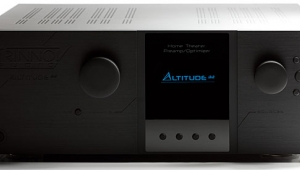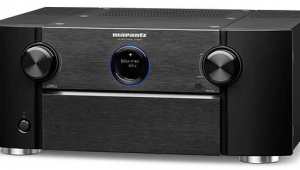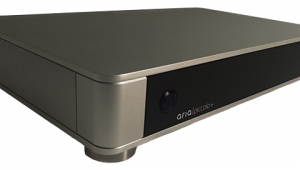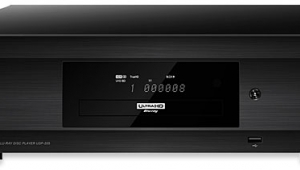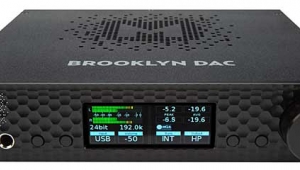| Columns Retired Columns & Blogs |
Music in the Round #22 Page 2
Other setup pages permit the user to define inputs by name and to select video source, digital audio source, analog audio source, gain offset, and audio preset (tone controls, channel trims, and lip-sync offset) for each input. Preferred processing modes (DPL IIx, Neo:6, Dolby EX, Surround 6.1, etc.) can also be preset, and are accessible from the remote control. All in all, the Controller is extremely logically structured.
Here's the feature I liked best: The 7.1-channel Analog Direct input uses the channel-balance adjustments specified for the digital inputs and adds analog bass management! For this unique input, you can select from the menu All Small speakers, All Large, or L&R Large (with the rest Small), and a fixed 80Hz crossover is applied to all settings. Sure, I'd like more options, such as L/C/R Large and/or adjustable crossover frequencies, but short of redigitizing the multichannel input, I don't expect it. For those of us who insist on using high-resolution SACD and DVD-Audio players with minimal or no bass management, the NHT Controller is one of the most audio-friendly pre-pros yet.
NHT Power5
This five-channel, 200Wpc power amplifier has the same sculpted front chassis as the Controller. It, too, has a touchscreen switch for On/Standby, and a bank of LEDs to indicate channel status. When a channel's LED is green, the channel is on and working properly. When red, the channel is in fault mode—but I never saw red.

The Power5's specs are impressive, with low distortion (<0.05% THD+noise at 200W each, all channels driven simultaneously, 0.001% IM and 0.01% TIM), soft clipping, and comprehensive protection features. The rear panel has five RCA jacks and five pairs of multiway binding posts. There are AC connections, a 12V trigger loop-through, and, interestingly, an Ethernet jack to permit the Power5 to communicate with the Controller so that the latter can control the Power5's On/Mute/Standby status. If set to two-channel output, the Controller will also shut down the Power5's center three channels so that its power supply can be optimized for output and heat reduction. In addition, the Controller can continuously monitor the Power5's operation. Full details and specs are available om NHT's website.)
Hooking Up
I'd just converted my system to all-balanced Kubala-Sosna connections between my Meridian 861 processor and Bryston 9B-ST power amplifier. And because I planned to incorporate the new Audyssey Sound Equalizer into this system, I also needed at least two sets of six RCA cables each. After discussions at Home Entertainment 2006 and the CEDIA Expo with cable designer Jay Victor and Belkin, I decided to try PureAV Silver Series RCA cables (AV50300). These are beautifully constructed, with hybrid PCOCC conductors, silver-solder joints, and substantial, color-coded connectors plated in 24K gold. And at only $39.99/1.2m, they seem underpriced. I especially like the solidity of the rubber grips on the connectors, and the PureAVs' slithery jackets make it easy to route them through the tangle of cables behind my rack. I briefly swapped the PureAV Silvers in the L/R channels for some pricier RCA cables from Alpha-Core and Straight Wire that I dug out of my closet, but found the Silvers equally clear and quiet. Firmly fitted to the NHT electronics, the Silvers were just the ticket for this system, and a challenge to higher-priced RCA links.
Up and Running
There was much to enjoy about the NHTs' sound. The Power5 amp was lively, powerful, and completely lacking in noise or hum. It had more than adequate power for the Paradigm Reference Studios, whether they were bass-managed or run full-range. Blockbusters like the Penderecki Credo (SACD, Polskie Radio PR SACD 1) or the new recording of Mahler's Symphony 6 from Christoph Eschenbach and the Philadelphia Orchestra (SACD, Ondine ODE 1084-SD) presented the Power5 with little challenge, even with all channels blazing. Subtlety and delicacy were served as well, as was evident with a lovely disc of Sibelius songs for soprano and orchestra; on Luonnotar, Soile Isokoski's voice soared over the orchestral flying carpet provided by Leif Segerstam and the Helsinki Philharmonic (SACD, Ondine ODE 1080-5). Compared to my reference Bryston 9B-ST, the Power5 seemed less overtly muscular while clearly not lacking for power. In fact, the more I listened to it, the more convincing it became—all of the audible spectrum was smoothly in balance.
The combination of the Power5 and Controller was addictive and will remain in my system a fair bit longer. The characteristic consistency across the channels made for a relatively seamless surround soundstage that rivaled that of the Meridian 861, especially with hi-rez SACDs and DVD-As, which the Meridian must redigitize. Run from the analog outputs of the Simaudio Moon Orbiter universal player, and with bass below 80Hz EQ'd by the Velodyne SMS-1, the five-channel output was remarkably transparent at all output levels through the Paradigms, and with simple as well as complex music.
The Penderecki and Mahler SACDs mentioned above were perfect demonstration discs, and all my long-term references confirmed the sound's honesty and consistency. Even nondiscrete surround sources were sources of delight. The 5.1-channel DTS soundtrack of a new DVD-V of Prokofiev's Love for Three Oranges, with Stéphane Denève conducting soloists and the Rotterdam Philharmonic Orchestra (BBC Audio Arts OA 0957D), was colorful and exciting, the voices up there on stage and the orchestra immediate and dynamic. The NHT Controller's DPL IIx processing did a dandy job with cable TV movies and music, too.
Overall, the $4750 combination of NHT's Controller and Power5 rivaled the best processor-amp partnerings I've used, and would be worthy of speakers even more sophisticated than the Paradigm Reference Studios. The Controller, in particular, offers a unique combination of intelligent design, audiophile considerations, and outright good sound far better than you'd expect at the price.
Next time In the Round
The new Audyssey Sound Equalizer and AudysseyPro software have just been installed between the NHT Controller and Power5, and I can say only two things about it at this point. First, when operated in bypass mode, the Audyssey's presence is marked only by slightly lower system gain. Second, when operated as intended, the new Audyssey is more effective than the version used in the receiver that I Denon AVR-4806 wrote about last March. This, and more—including an interview about multichannel recording with conductor Ivan Fischer—next time in the Round.
- Log in or register to post comments


